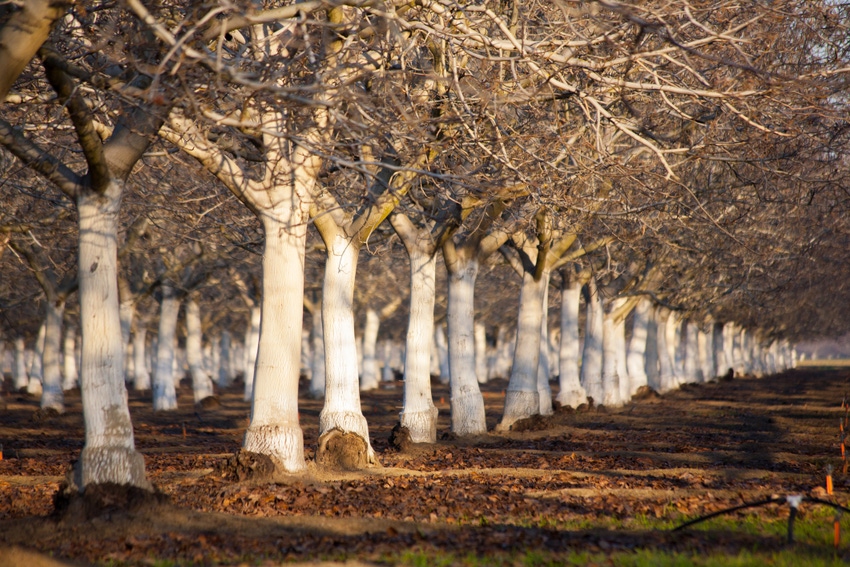
Dust has settled from the 2017 almond harvest, but there are late fall chores that may keep growers and managers in the orchards over the next several weeks.
Scouting and removing mummy nuts, cleaning orchard floors in preparation for herbicide applications, pruning, and applying soil amendments are all grower priorities this time of year through the dormant season, says Mohammad Yaghmour, University of California (UC) Cooperative Extension orchard systems advisor at Kern County, Calif.
At the top of the list is the removal of overwintering sites for Navel orangeworm (NOW). Sticktight nuts on the tree or mummies on the ground are prime overwintering places for NOW.
Orchards with higher NOW damage this year should have increased sanitation work to remove and destroy mummy nuts. NOW larvae overwinter inside almond shells or hulls, and then emerge as adults in the spring to start the first flight as the temperature warms. Successive generations hit almonds at hull split and damage the crop.
Be aggressive
Integral Ag pest control advisor Justin Nay of Durham, Calif. suggests that growers be aggressive with the orchard when fall crack outs show NOW larvae are present.
“If 30 percent or more are showing worms, this is a problem block and growers should pay more attention to orchard sanitation,” Nay said.
Not only should shells be inspected for NOW, but also the hulls since the pest can overwinter there. After shaking or knocking mummy nuts and hulls to the ground, they should be blown and swept into windrows and destroyed by flail mowing.
Growers sometimes wait until after the first rain for the sanitation shake, Yaghmour says, since mummy nuts are heavier and more likely to fall off the tree. However, this strategy can back fire as last winter’s rains prevented orchard sanitation in many blocks.
Pruning guidelines
As trees enter dormancy, pruning is another chore on the list. In mature orchards, branches that are dead, broken, or interfere with shaking should be removed.
It is important to time tree pruning to avoid rain events. Yaghmour says pruning wounds are susceptible to infections from canker disease as the spores are dispersed and spread by rain. Pruning wounds are susceptible to infection for at least two weeks, and larger wounds may take longer to heal.
Pre-emergent applications
Before pre-emergent herbicide applications are applied, growers should identify which weeds are causing problems in orchards and if past herbicide applications have been successful. UC Integrated Pest Management guidelines continue to suggest alternating products with different modes of action.
One strategy is to treat in November and December for winter weeds with a low rate of glyphosate with a soil residual herbicide including Chateau, Matrix, Alion, or Pindar GT. Wait to apply Surflan or Prowl in February or March to achieve summer long weed control. Keep orchard floors and berms clean for maximum effect.
Other winter tasks
Yaghmour says soil sampling, a July leaf analysis, and hull boron analysis should be the guides for nutrient applications. Potassium is an important element which can be applied during the dormant period. Almond nutrient management includes replacing nutrients removed from an orchard at harvest to maintain productivity.
Like nitrogen, potassium should be replaced based on the pounds of kernels harvested per acre. For every 1,000 pounds of harvested kernels, 85-95 pounds of potassium oxide (K2O) can be applied (equivalent to 70-80 pounds of elemental K).
The amount of the potassium budget applied during the winter months varies depending on the soil type. In soils with high cation exchange capacity (CEC), K can be applied in just one application during winter. However, in low CEC soils, a partial amount of the budgeted potassium should be applied later in the dormant period with 40-60 percent of the K budget applied in-season.
Nay says many growers use this time of year to spread gypsum or compost in orchards and apply micro nutrient blends. In North State growing regions, he says growers can also apply zinc to help with wind damage and limit rust.
Soil samples can determine if a leaching program is necessary to flush salts below the root zone.
About the Author(s)
You May Also Like




